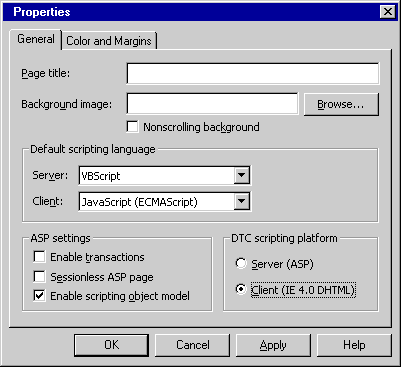Using Client Database Features
One beneficial feature of Visual InterDev 6.0 is the new support for DHTML clients. The Data Environment and DTCs can support DHTML clients such as Microsoft Internet Explorer 4.
By default, the DTC scripting platform is set to Server (ASP) for every new project. You can change this setting for all new pages in the project by displaying the Project Properties dialog box, clicking the Editor Defaults tab, and then selecting the Client (IE 4.0 DHTML) option. Changing this setting for the project after you have created data-driven pages does not affect the existing pages.
You can, however, change this setting for each page and for each DTC. Figure 5-16 shows the Properties dialog box for an ASP Web page. Notice that I have changed the DTC Scripting Platform setting to Client (IE 4.0 DHTML). As soon as this page is saved, the DTCs on the page inherit the change in the scripting platform. The inheritance from the page is the default action. You can override these settings for each DTC.
Now you are in for a surprise. Running pages with DTCs executing on the client does several things:
- The DTCs are implemented as objects on the client.
- The page is not redisplayed each time the user moves between records.
- The application's demands on the server decrease.
When you use DTCs and implement them as client objects, the database features are implemented using Remote Data Services (RDS). Using RDS pushes the database recordset down to the client and lets the client do most of the work. The load placed on both the network server and the network also decrease.
Client database features are covered in detail in Chapter 16.

Figure 5-16. The Page Properties dialog box allows you to change the scripting platform for DTCs on the page.
EAN: 2147483647
Pages: 143